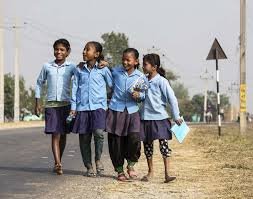UNICEF Unveils National Roadmap for Child Road Safety
Introduction
UNICEF has launched a comprehensive national roadmap aimed at enhancing child road safety in India. This initiative comes as part of efforts to address the increasing number of child fatalities and injuries caused by road accidents. The roadmap outlines strategic interventions to ensure safer road environments for children.
Key Features of the Roadmap
- Safer School Zones: The roadmap advocates for creating secure zones around schools to prevent road accidents involving children.
- Traffic Regulation Enhancement: A major focus is on improving traffic rules, especially those targeting areas with high pedestrian activity like school zones.
- Awareness Campaigns: UNICEF emphasizes educating children, parents, and the general public on road safety to foster a collective effort toward reducing accidents.
- Collaboration Across Stakeholders: The roadmap calls for active involvement from governments, educational institutions, and communities to work together for road safety.

Why This News Is Important
Reducing Road Accidents and Child Mortality
With over 5,000 children losing their lives annually in road accidents across India, the roadmap aims to reverse this trend by implementing critical safety measures. This initiative has the potential to reduce fatalities by creating safer routes for children, particularly in urban areas where traffic congestion is a concern.
Impact on Policy and Governance
UNICEF’s roadmap provides a structured framework for state and national governments to implement child-centric road safety laws. It may also prompt legislative changes regarding pedestrian safety, making it easier for children to commute to schools without fear of accidents.
Increased Awareness and Education
Awareness campaigns included in the roadmap are crucial for educating both children and parents about road safety practices. This shift toward preventive measures can lead to long-term improvements in child safety across India.
Historical Context:
India has one of the highest rates of road accidents in the world, and the number of children involved in these accidents has been steadily rising. Historically, road safety for children has not been a priority in policy-making. UNICEF’s intervention represents a growing recognition of the need to prioritize children’s safety in public spaces, particularly around educational institutions.
Key Takeaways from UNICEF’s National Roadmap for Child Road Safety
| S.No. | Key Takeaway |
|---|---|
| 1 | UNICEF has introduced a national roadmap focused on child road safety in India. |
| 2 | The roadmap includes the creation of safer school zones and improved traffic regulations. |
| 3 | Public awareness campaigns targeting children and parents are a crucial element of the plan. |
| 4 | Collaboration between government bodies, schools, and communities is key to its success. |
| 5 | The roadmap aims to significantly reduce child fatalities and injuries caused by road accidents. |
Important FAQs for Students from this News
1. What is the UNICEF National Roadmap for Child Road Safety?
UNICEF’s National Roadmap for Child Road Safety is a strategic plan aimed at reducing child fatalities and injuries from road accidents in India. It includes measures like safer school zones, enhanced traffic regulations, and public awareness campaigns.
2. Why is child road safety important?
Children are particularly vulnerable in traffic-related accidents. Improving road safety through education and infrastructure changes can significantly reduce fatalities and injuries, ensuring safer environments for children, especially around schools.
3. Who is involved in the implementation of the roadmap?
The roadmap involves collaboration among government bodies, schools, communities, and parents to work together in ensuring child road safety. It also seeks active participation from educational institutions and local authorities.
4. What are the key strategies of the roadmap?
The roadmap emphasizes creating safer school zones, enhancing traffic regulations, conducting awareness campaigns, and fostering collaboration among various stakeholders to improve child road safety.
5. How will the roadmap impact Indian children?
The roadmap aims to reduce child road fatalities significantly by creating safer transportation routes, educating children and parents, and improving infrastructure. This initiative can lead to a safer environment for children to walk or cycle to school.
Some Important Current Affairs Links















